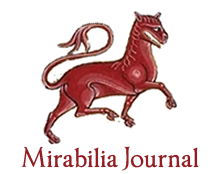The Aesthetic dimension of Existence. Life as a work of art. From Socrates (c.470-399) to Saint Augustine (354-430)
María CECILIA COLOMBANI
Original title: La dimensión estética de la existencia. La vida como obra de arte. De Sócrates (c.470-399) a San Agustín (354-430)
Published in The Medieval Aesthetics
Keywords: Confession, Foucault, Parrhesia, Truth.
The present communication consists of highlighting certain features of the parrhesiastic dimension present in Socrates so that, from this theoretical presupposition, we can develop an arc of reading with the confession in Saint Augustine. The purpose is to build a line of continuity with what we can consider an act of veridiction in the Foucauldian sense. We are motivated by the interest in marking a line between a parrhesiastic function and a confessional device and see what ethical-anthropological consequences are given from such acts. Above all, how both discursive practices, which obey specific rules of formation, are related to the so-called arts of existence linked to the etho-poietic dimension of making life a work of art; this is the path we want to travel to think the aesthetic question, associated with ethics and politics, as acts that occur within the framework of power relations that produce transformations on the real.
The Aesthetics of the Interpretation of Dreams
José Eduardo Costa SILVA, Ernesto HARTMANN
Original title: A Estética da Interpretação dos Sonhos
Published in Art, Criticism and Mysticism
Keywords: Aesthetics, Freud., The Interpretation of Dreams.
This paper presents a philosophical study of the tensions and interconections between Aesthetics and Logic in The Interpretation of Dreams by Sigmund Freud (1856-1939). We wish to demonstrate how Freud in this text which is strategic for the establishment of psychoanalytic praxis and that resonates in contemporary artistic movements, establishes a method supported in the accuracy of observation and logic and, at the same time, invocates in aid to this method notions of representation, form, content and unit, seemingly opposing thus the idealist philosophical tradition, historically founded in the distinction between the intelligible and the sensible.
The Alfonsine Guzman ladies. A feminine dynasty in Castile, 13th-14th centuries
Pablo MARTÍN PRIETO
Original title: Las Guzmán alfonsinas. Una dinastía femenina en la Castilla de los siglos XIII y XIV
Published in Mulier aut Femina. Idealism or reality of women in the Middle Ages
Keywords: Alfonso X, Beatriz of Portugal, Blanca of Portugal, Guzman, Mayor Guillen.
From the mid-13th century, the relationship between Alfonso X of Castile and his mistress Mayor Guillen de Guzman gave rise to a veritable feminine dynasty, beginning with their daughter Beatriz − later Queen of Portugal through her marriage − and continued through the latter's daughter, Princess Blanca of Portugal, the grand-daughter of Mayor Guillen, well until the 1320s. In this time, the ladies belonging to this illegitimate line of Alfonso X's descent kept a special commitment to the Castilian crown, as well as to certain interests of piety and power related to this king. The continuity along this Alfonsine line of the important noble family of Guzman stands as a showcase of the public relevance of women set in a high environment.
The All-seeing of Nicholas of Cusa: Icon or Picture?
Anca MANOLESCU
Original title: L’omnivoyant de Nicolas de Cues: tableau ou icône?
Published in Nicholas of Cusa in Dialogue
Keywords: Icon, Path of mystical knowledge, Picture, Theory of image.
The treaty De visione Dei, with the alternative title De icona, was translated in French by Agnès Minazzoli as Le tableau ou la vision de Dieu. The path of mystical knowledge commences indeed with an image of the All-seeing: an image which is „artistic”, „manufactured”, as the one produced by the art of the „great master Roger”. But in the „experiment” for which Nicholas of Cusa gathered his friends, the Benedictines of Tegernsee, is this image regarded just as an artistic picture? Does the „meeting of eyes” between the monks and the portrait not have the intensity of a personal communication? Hence, we wonder if Nicholas of Cusa does not regard this image as both a picture and an icon. The picture manufactured by artistic craft, the icon that houses the presence of the divine – what is the relation between these two instances of image in the cardinal’s thought? It has already been said that Nicholas of Cusa has phrased the content of medieval Wisdom in the modern language of the Renaissance. But doesn’t he also propose a new way of relating to the image of the divine? A way that blends concepts from both Eastern and Western Christianity and still manages to innovate on both „official” theories of image.
The Annunciation as the locus of return of the figured logos
Alexandre Emerick NEVES
Original title: A Anunciação como o locus de retorno do logos figurado
Published in
Keywords: Annunciation, Medieval aesthetics, Modes of figuring the body, Movement, Place, Stoicism, Time.
The approximation of philosophical thought with theological precepts has brought about the conciliation of the presuppositions of Greco-Roman culture with Christian mysticism, of the concepts erected by rationalism with what is supposed divinely revealed, which seems to intuit the dimension of this event so represented in medieval aesthetics and Renaissance, namely, the annunciation of the logos taken as the divine virtue in the way of being fully revealed and manifested in the pictorial locus. More than a religious motif, it is the proclamation of a thought based on Aristotelian metaphysics, modeled on Stoicism and refined by Augustine and Thomas Aquinas, manifested in medieval aesthetics, especially in the retable of Simone Martini. The mystery of the incarnation intuits the convergence of the suprasensible with the world of appearances. Anticipated by the figuration of the Word announced, it presupposes the ontological status of origin and the speculative treatment of time, movement and place, from a comparative exercise between the descriptive aspects of the biblical narrative and its return figured in artistic beauty.
The Annunciation in Fra Filippo Lippi: interpreting some symbolic variants
José María SALVADOR GONZÁLEZ
Original title: The Annunciation in Fra Filippo Lippi: interpreting some symbolic variants
Published in
Keywords: Annunciation, Christianity, Fra Filippo Lippi, Mariology, Medieval iconography, Patristics.
The Arbitral Sentence Regarding Walls and Valleys from 1406. Study and Edition
Agustí CAMPOS PERALES
Original title: La sentència arbitral de murs i valls del 1406. Estudi i edició
Published in
Keywords: Edició, Junta de Murs i Valls, Manuscrit, Medieval, Urbanisme.
Public urbanism during the late middle ages in Valencia was regulated by the activity of the Jurats, their executive power, and the Junta de Murs i Valls, an institution created in 1358 to manage the constructions of walls, moats or roads inside the city’s boundaries. This institution (the Junta), however, was not provided with a legal basis until 1406 when an arbitral sentence between the city of Valencia and the military estate was promulgated. From this agreement or sentence, an edition of which is included in this article, we can know the legal and administrative development of this institution as well details on construction activities in medieval Valencia.
The Archives of the Crown of Aragon, philological treasure for the juridical linguistic studies
Cristina CARVALHO
Original title: Les Archives de la Couronne d’Aragon, trésor philologique à exploiter par l’approche linguistique juridique
Published in
Keywords: Archives, Legal, Linguistics, Methodology, Research.
The Aragon Crown Archives gather historical documentary resources that constitute excellent corpus for legal linguistics research. We will strengthen this statement by showing, on the one hand, the methodology to follow in order to unearth singular collections and, on the other hand, by demonstrating why these Archive’s historical documentary resources are a clear referent for linguistics approach.
The Ave Maria for four voice mixed choir attributed to Tomás Luis de Victoria (1548-1611): a hermeneutic analysis of the text/compositional procedures relations
Ernesto HARTMANN
Original title: A Ave Maria para coro misto a quatro vozes atribuída a Tomás Luis de Victoria (1548-1611): uma análise hermenêutica das relações entre texto e processos composicionais
Published in
Keywords: Ave Maria, Hermeneutical Windows, Tomás Luis de Victoria.
This research examines the work Ave Maria for mixed choir attributed to Iberian composer Tomás Luis de Victoria (1548-1611). Seeking for new analytical perspectives I apply the notion of hermeneutical windows, by Lawrence Kramer, in order to elucidate the relations of the text and compositional procedures in the work. To do so, I first present a brief historical perspective of musical representation of text, I analyze the work outlining its texture, church mode and metric choices and discuss the results in order to open the hermeneutical windows and reach the possible meaning beyond the text.
The Beauty and Love in Ibn Sīnā (980-1037)
Ricardo da COSTA, Evandro Santana PEREIRA
Original title: O Belo e o Amor em Ibn Sīnā (980-1037)
Published in
Keywords: Aesthetics, Beauty., Ibn Sīnā, Love.
This paper analyses the subjects of Love and Beauty in the Risalah fi’l- ‘ishq (A Treatise on Love) of the philosopher Ibn Sīnā (980-1037).






















































































